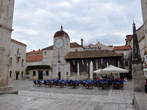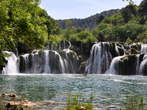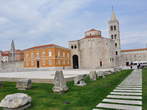Trogir is a historically and culturally rich town located on the central Dalmatian coast of Croatia, approximately 25 kilometers west of Split. The town lies on a small islet between the mainland and the island of Ciovo, connected by bridges, which gives it a unique geographical character.
Due to its exceptional architectural heritage, spanning from antiquity to the Renaissance and Baroque periods, the old town center is listed as a UNESCO World Heritage Site. The Trogir Bridge is one of the key transport links providing access to the historic town. This picturesque Dalmatian gem is situated on a small islet between the mainland and Ciovo, connected to both sides by stone bridges. The bridge crosses a narrow channel and has been important to the local population and visitors for centuries. In addition to the old bridge, the newer Ciovo Bridge now helps ease traffic congestion, especially during the summer months. In the past, there was a smaller bridge at this location, while today's structure allows for better traffic flow. Trogir has a history spanning over 2,000 years. It was founded by the Greeks in the 3rd century BC as the colony Tragurion, later developed by the Romans, Byzantines, Venetians, and Habsburgs. This rich history is reflected in the exceptionally well-preserved buildings and monuments that adorn the town. The main landmarks in Trogir include the Cathedral of St. Lawrence, Kamerlengo Fortress, Cipiko Palace, the Town Loggia and Clock, and the Monastery of St. Nicholas.
The cathedral is one of the finest examples of Romanesque and Gothic architecture in Croatia. Its most remarkable feature is the portal of Master Radovan from 1240, considered a masterpiece of medieval sculpture in Dalmatia. Kamerlengo Fortress is one of Trogir’s most recognizable historical landmarks. Built in the 15th century under Venetian rule, it served as a defensive stronghold against potential land and sea attacks. Located on the western side of the old town, right by the coast, it offers stunning views of Trogir and the surrounding islands. The fortress walls are excellently preserved, and its main tower still stands as a testament to the military power of its time. Today, Kamerlengo is a popular tourist attraction and a venue for various cultural events, including concerts and theater performances held within its mighty walls. Visitors can explore the fortress and climb its walls for panoramic views of the Adriatic Sea. Cipiko Palace is a complex of buildings that belonged to the influential Cipiko family, showcasing the wealth of Venetian Gothic and Renaissance art. On the main square stands the elegant Town Loggia, where public trials and political discussions were once held. The Monastery of St. Nicholas houses a valuable collection of artworks, including the famous relief of the god Kairos from the 3rd century BC.
Trogir is not only a historic town but also a lively tourist destination. Its narrow stone streets, Mediterranean houses, flower-adorned balconies, and hidden corners create a romantic atmosphere that attracts many visitors. A walk along the town walls or the seaside promenade Riva offers stunning views of luxury yachts and breathtaking sunsets.






















 HR-CRO - Croatia
HR-CRO - Croatia




















